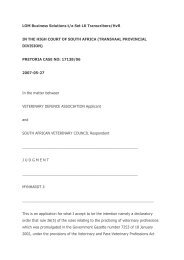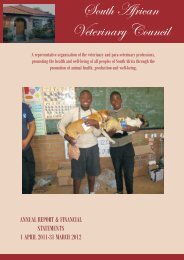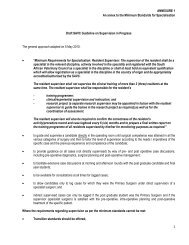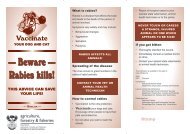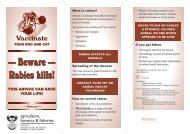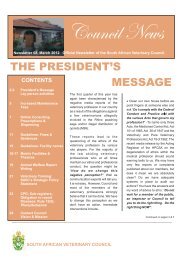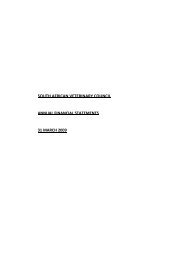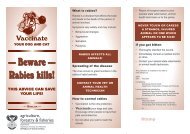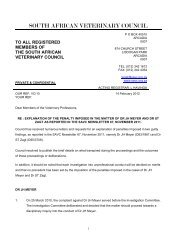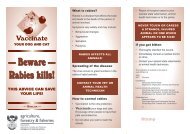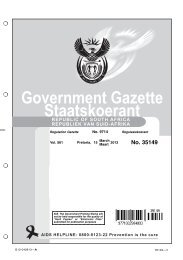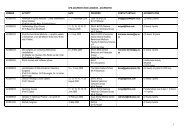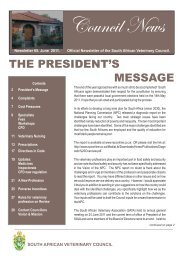Rabies Guide 2010.pdf - the South African Veterinary Council
Rabies Guide 2010.pdf - the South African Veterinary Council
Rabies Guide 2010.pdf - the South African Veterinary Council
You also want an ePaper? Increase the reach of your titles
YUMPU automatically turns print PDFs into web optimized ePapers that Google loves.
<strong>Rabies</strong> contact animals<br />
Contact animals are animals that have been, or are<br />
suspected to have been, bitten or scratched by a rabid<br />
animal, or received saliva, brain or o<strong>the</strong>r infectious<br />
material from a rabid animal into a wound, <strong>the</strong><br />
mouth or eyes. This includes <strong>the</strong> unweaned offspring<br />
of infected animals.<br />
and/or destroyed by an authorised person subject<br />
to conditions determined by <strong>the</strong> state veterinarian.<br />
Unvaccinated contact livestock including cattle, sheep,<br />
goats and horses may, in exceptional cases and subject<br />
to written permission and conditions determined<br />
by <strong>the</strong> state veterinarian, be immunised and held in<br />
isolation and close observation for six months.<br />
The management of contact domestic animals<br />
exposed to rabies can be complicated by <strong>the</strong> lack<br />
of an immediate perceived threat to human life. As<br />
human exposure is likely should a domestic animal<br />
develop rabies, <strong>the</strong> recommendation is normally to<br />
cull <strong>the</strong> exposed animal.<br />
Management of <strong>the</strong>se<br />
cases is difficult because<br />
of emotional attachment<br />
to <strong>the</strong> animal, <strong>the</strong> value<br />
of <strong>the</strong> animal, difficulties<br />
in determining vaccination<br />
status and <strong>the</strong> democratic<br />
rights of individuals.<br />
It is imperative that<br />
contact animals be traced, identified, safely confined<br />
and reported to <strong>the</strong> state veterinarian without delay.<br />
Failure to report such cases may subsequently result<br />
in <strong>the</strong> spread of <strong>the</strong> disease to humans or o<strong>the</strong>r<br />
animals. The state veterinarian will determine which<br />
contact animals pose a risk and what control measures<br />
are necessary to prevent any fur<strong>the</strong>r spread of <strong>the</strong><br />
disease.<br />
Where rabies is confirmed in wild carnivores,<br />
mongooses, dogs and cats, all dogs and cats that<br />
were in close contact with <strong>the</strong> infected animal, for<br />
example those of <strong>the</strong> same household, must be<br />
euthanised under <strong>the</strong> supervision of a veterinary<br />
officer or authorised person, if <strong>the</strong>y do not have a<br />
valid vaccination certificate.<br />
Livestock known to have been bitten should be<br />
slaughtered immediately. 153 Equines must be isolated<br />
It is imperative that contact<br />
animals be traced, identified,<br />
confined safely and reported<br />
to <strong>the</strong> state veterinarian<br />
without delay<br />
Tissue and milk from a rabid animal should not be<br />
used for human or animal consumption. Meat that<br />
has been cooked and milk that has been pasteurised or<br />
refrigerated should not pose a danger. People drinking<br />
raw milk and butchering a carcass should, however,<br />
be regarded as a category 2 contact and should be<br />
vaccinated.<br />
After taking samples from<br />
an animal with rabies or<br />
suspected of having rabies,<br />
carcasses must be burnt or<br />
buried.<br />
A test to determine rabies<br />
antibody titre in previously<br />
vaccinated cats and dogs after an exposure to rabies<br />
occurred is available at OVI. This test can determine<br />
whe<strong>the</strong>r efficient antibody titres were obtained after<br />
vaccination that will protect against rabies virus<br />
infection. However this test cannot indicate whe<strong>the</strong>r<br />
<strong>the</strong> animal is incubating <strong>the</strong> virus.<br />
Vaccinated dogs and cats with neutralising antibody<br />
titres exceeding of 0,5 IU/ml can be considered<br />
to have responded to vaccination, although <strong>the</strong><br />
presence of neutralising antibodies does not guarantee<br />
protection against challenge. This result may assist<br />
in managing contact animals. It is essential that a<br />
full history is obtained and that blood samples are<br />
taken before booster vaccination (within 1–2 days<br />
post-exposure). Fur<strong>the</strong>rmore, <strong>the</strong> date(s) and type of<br />
contact, for example bite, scratch, and information<br />
on blood sampling and rabies vaccination(s) must be<br />
submitted with <strong>the</strong> serum samples.<br />
51



